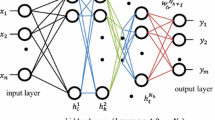Abstract
Fetal condition during labour is inferred from a continuous display of fetal heartrate and uterine contractions called the cardiotocogram (CTG). The CTG requires a considerable expertise for correct interpretation, which is not always available. We are developing an intelligent system to support clinical decision-making during labour. The system’s performance depends on its ability to classify features from the CTG similarly to experts. Artificial neural networks 9NNs) can be taught by experts for such tasks, and so may be particularly suitable. We found NNs suitable for feature extraction when the problem was reduced to small well defined tasks, and numerical algorithms were used to pre-process the raw data before application to the NNs. A NN with optimised dimensions was used in this way to classify the magnitude of decelerations, a feature clinicians find particularly difficult. The NN was compared with the algorithm used in a commercial antenatal monitor* and six reviewers which included two CTG experts. The experts were consistent (89·7% and 97·0%) and agreed well with each other (81·0%), whereas the non-experts were less consistent and agreed less well. The NN agreed well with the experts (75·0% and 81·9%) but the algorithm agreed poorly (56.5% and 68·9%). It was found that the algorithm’s performance could be improved (71·1% and 76·7%) when modified to use additional information. Our earlier attempts to fully classify the raw CTG using a single NN were unsuccessful because of the large number of data patterns. A simplified approach to classify the magnitude and timing of decelerations was also unsuitable when contraction data was of poor quality or absent. We have adopted a hybrid approach for our intelligent system for reliability and improved performance. CTG features are extracted and classified by combined numerical algorithms and small NNs. These features, together with patient information, are then processed by an expert system which allows interaction with clinicians.
Similar content being viewed by others
References
Allred, L. G., andKelly, G. E. (1990): ‘Supervised learning techniques for backpropagation networks’. Proc. Int. Joint Conf. on Neural Networks, 17–21 July, San Diego (IEEE Neural Networks Council) pp. 721–728
American College of Obstetricians and Gynaecologists (1972): ‘Technical bulletin 32: guidelines for monitoring terminology and instrumentation’ (Harper and Row, Hagerstown, Pennsylvania, USA)
Dawes, G. S., Moulden, M., andRedman, C. W. G. (1991): ‘System 8000: computerized antenatal FHR analysis’,J. Perinat. Med.,19, pp. 47–51
Ennis, M., andVincent, C. A. (1990): ‘Obstetric accidents: a review of 64 cases’,Br. Med. J.,300, pp. 1365–1367
Haverkamp, A. D., Orleans, M., Langendoerfer, S., Macfee, J., Murphy, J., andThompson, H. (1979): ‘A controlled trial of the differential effects of intrapartum fetal monitoring’,Amer. J. Obstet. Gynecol.,134, pp. 399–408
Hon, E. H. (1963): ‘The classification of fetal heart rate I: a working classification’,Obstet. Gynecol.,22, pp. 137–146
Hon, E. H., andQuilligan, E. J. (1967): ‘The classification of fetal heart rate II: a revised working classification’,Conn. Med. J.,31, pp. 779–784
Ifeachor, E. C., Keith, R. D. F., Westgate, J., andGreene, K. R. (1991): ‘An expert system to assist in the management of labour’, Expert Systems World Congress Proc., Orlando Florida, 16–19 December (Liebowitz, J. (Ed)) (Pergamon-Press, Oxford, UK). Vol. 4, pp. 2615–2622
Krause W. (1990): ‘Natalie by Niess. A computer-aided monitoring system for supervision of labour,Maeda, K. (Ed)in, Computers in perinatal medicine’ (Elsevier Science Publishers, B. V. Amsterdam) pp. 103–111
Lidegaard, O., Bottcher, L. M., andWeber, T. (1992): ‘Description, evaluation and clinical decision making according to various fetal heart rate patterns: inter-observer and regional variability’,Acta. Obstet. Gynecol. Scand.,71, pp. 48–53
Maeda, K. (1990): ‘Computerised analysis of cardiotocograms and fetal movements,Lilford, R. (Ed.)in: Balliere’s clinical obstetrics and gynaecology’, Vol. 4, pp. 797–81
Murphy, K. W., Johnson, P., Moorrcraft, J., Pattinson, R., Russell, V., andTurnball, A. (1990): ‘Birth asphysia and the intrapartum cardiotocograph’,Br. J. Obstet. Gynaecol.,97, pp. 470–479
Rumelhart, D. E., Hinton, G. E., andWilliams, R. J. (1986): ‘Learning internal representations by error propagation’in Feldman, J. A., Hayes, P. J., andRumelhart, D. E. (Eds.): ‘Parallel distribution processing’ Vol. 1 318–362. (MIT Press, Cambridge, Massachusetts) Vol. 1, pp. 318–362
Simpson, P. K. (1989): ‘Artificial neural systems, foundations, paradigms, applications and implementations’ (Pergamon Press, Oxford, UK)
Author information
Authors and Affiliations
Rights and permissions
About this article
Cite this article
Keith, R.D.F., Westgate, J., Ifeachor, E.C. et al. Suitability of artificial neural networks for feature extraction from cardiotocogram during labour. Med. Biol. Eng. Comput. 32 (Suppl 1), S51–S57 (1994). https://doi.org/10.1007/BF02523327
Received:
Accepted:
Issue Date:
DOI: https://doi.org/10.1007/BF02523327




